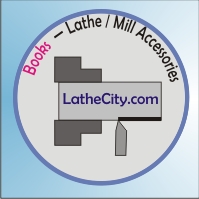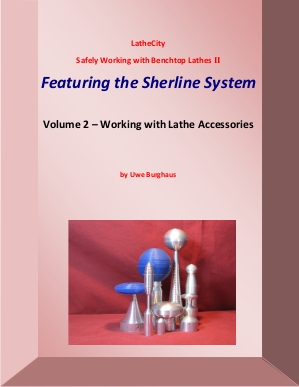Volume 2: working with lathe accessories
Copyrights
Disclaimer
Part A: Introduction
1. Required safety notes
2. Introduction
2.1 What topics are included?
2.2 Why should you purchase this book?
2.3 Does it make sense to learn practical procedures with a textbook?
2.4 How is the book structured?
2.5 Are other volumes available?
2.6 Are accessories from other vendors besides Sherline available?
2.7 Should I make my own accessories?
3. Brief summary of standard lathe operations
3.1 Different lathe types are in use
3.2 Basic idea of cutting operations in a lathe
3.3 Summary of basic lathe operations
3.4 Turning speeds
4. A few notes about cutting tools and cutting materials
4.1 High-speed steel
4.2 Carbide tools
4.3 Inserted tip cutter
4.4 Fast change tool posts
4.5 Rake angles
5. A few notes about materials trends and standards
5.1 What is steel actually?
5.2 A few materials trends
5.3 A few materials properties
5.4 Surface finishing
6. The world beyond aluminum
Working with Alloy steel, Aluminum Bronze, Brass, Cast Iron, Cold pressed Steel C1018, Ceramics – Macor, Cork, Copper, pure Manganese, Magnets, Plastics, Rocks, Sandwich structures – hardened steel, Stainless steel, Styrofoam, Sterling Silver, Hardening Sterling Silver, HSS, Tool Steel, Lead-loy, Titanium, Wax, Wood
Part B: ACCESSORIES
7. Compound slide
7.1 Safety, objects, size of the accessory
7.2 Tool mounting
7.3 Compound slide and live center
7.4 Turning operations
7.5 Facing operations
7.6 Positive/negative taper
7.7 Turning a positive taper
7.8 Turning a negative taper
7.9 Turning internal taper
7.10 Doing this more precisely
7.11 Calculate taper angles
7.12 Maintenance and trouble shooting
7.13 Projects (earrings, Lathe City miniatures, Morse taper)
8. Radius cutting
8.1 Object
8.2 Design strategies of radius cutter
8.3 How it works? First test cut for a half sphere (convex radius, outward curving)
8.4 Cutting a concave (inward curving) radius
8.5 Projects using the circle cutter
(Chess figure, cutting nearly a full sphere, large diameter spheres, water tower, earning, making a ball joint, pencil container, gyroscope)
9. Riser block upgrades
10. Cutting threads
10.1 Advantages of cutting threads in a lathe
10.2 Disadvantage of cutting threads in a lathe
10.3 Thread design and standards
10.4 Idea of cutting threads in a lathe
10.5 Other techniques for cutting threads
10.6 Setting up the thread cutter
10.7 Typical procedure – making the first screw (external and right handed thread)
10.8 Cutting internal threads (nuts)
10.9 Cutting left handed threads
10.10 Metric screws
10.11 Cutting low pitch threads – trouble shooting
10.12 Using the compound slide for cutting threads
10.13 Double lead threads / double start threads
10.14 Cutting threads on a taper shape
10.15 Using a lathe as a hand taping machine?
10.16 Further curiosities – perhaps interesting
10.17 “Art” work / accessories with special screws? – a few suggestions for projects.
10.18 Trouble shooting
10.19 Literature
Part C: TIPS AND TRICKS
11. Sharpening and grinding HSS cuttings tools
11.1 A few simple engineering terms and notes
11.2 Sharpening lathe tools
11.3 Friendly suggestions for grinding HSS blanks
11.4 Simple form tools
11.4 Grooving tools
11.5 Boring tools
11.6 Grinding right hand (RH) cutter
11.7 Grinding left hand (LH) cutter
11.8 Grinding other HSS tools
12. Poor man’s CNC system, or, how to cut fancier shapes with a manual lathe?
13. What is next?
Appendices
Index |


